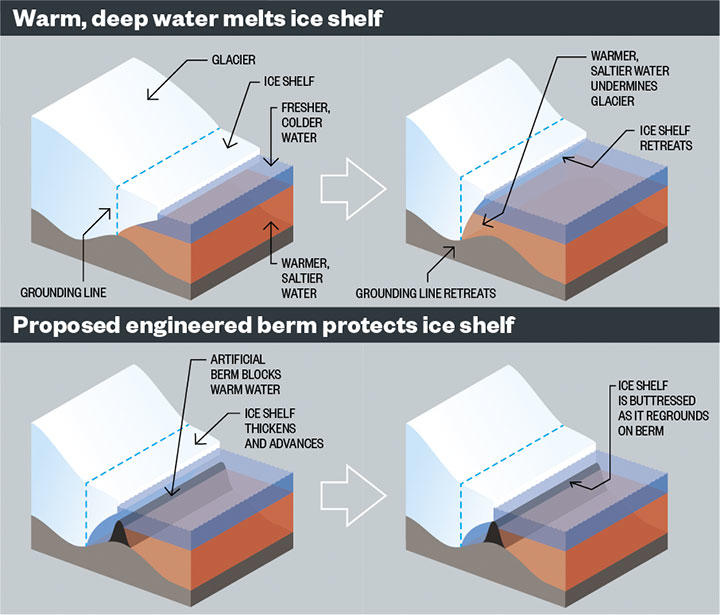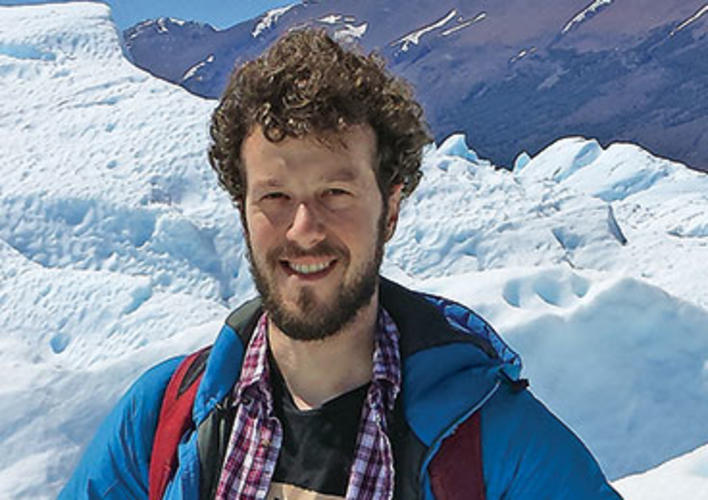Atmospheric and Oceanic Sciences: Glacial Brace
A dramatic proposal to stem sea-level rise through geoengineering
It was the crack heard ’round the world. After years of anticipation, Antarctica’s Larsen C ice shelf broke last summer, sending adrift an iceberg the size of Delaware. While that iceberg was relatively small compared to the vast quantities of ice stored in Antarctica and Greenland, the shelf’s sudden demise highlighted the precariousness of ice packs at the poles and the catastrophic effects that could ensue from widespread glacial and ice-sheet melting. At predicted rates of global warming, sea levels could rise by more than 3 feet by 2100, displacing millions of people around the world and causing damages of $20 billion to $70 billion a year.
Geoengineering Glaciers: How It Could Work
Postdoc Michael Wolovick is proposing shielding glaciers from the warm water deep in the ocean. Early calculations suggest the intervention could drastically slow the glaciers’ contribution to sea-level rise.
Geophysicist Michael Wolovick has spent two years at Princeton studying glaciers in Antarctica and Greenland, and he sees hope. The areas where the major glaciers stream into the sea are remarkably narrow. By shielding glaciers in just those small areas from the warmer, saltier water in the deep ocean, sea-level rise might be stemmed.
“In Greenland, many [glaciers] are 5 kilometers or less — there are bridges longer than that,” says Wolovick, who wrapped up his postdoctoral research at Princeton in April. Even in Antarctica, where ice shelves are about 25 miles wide, Wolovick adds, the potential benefit to society of slowing their flow could well outweigh the cost.
Scientists attempting to stave off the harmful effects of climate change have proposed geoengineering projects to remove greenhouse gases from the atmosphere or redirect solar radiation back into space. In an article published in Nature in March, Wolovick and three co-authors argue for smaller-scale intervention that would employ geoengineering to slow glaciers’ melting, thereby reducing the rate of sea-level rise, one of climate change’s most dire effects.
Each glacier has a grounding line, the point at which it lifts off the ocean floor and floats, displacing sea water and causing the ocean to rise. Wolovick’s paper proposes an underwater berm made up of giant, flat piles of sand and rock in front of the glacier to protect its gounding line from the warm layer of water that tends to cause it to recede.
Blocking warm-water currents wouldn’t be a complete solution to climate change, but it could slow melting. With less warm water gnawing at the glaciers’ grounding line, Wolovick’s computer-generated models suggest some glaciers may even gain mass, and in the best-case scenario, their bases could become even stronger by eventually attaching to the berms.
The challenge is more complicated in Antarctica because its ice shelves mostly float and have a less substantial base attached to the seafloor. But even here, Wolovick believes that their impact on sea-level rise can be stemmed by building underwater “pinning points” to reground them. “That might thicken the ice shelf and reduce the rate of mass loss,” he says. In statistical models he’s constructed, by grounding a glacier to the ocean floor, the amount of sea level rise from the glacier melting and displacing water is reduced by at least a factor of five.
The trick is building the berm or pinning points in the right places. Wolovick’s models show that if a berm blocked only half the warm water in front of a glacier, there is a 70 percent chance of it regrounding to the ocean floor. For the next phase of his still-hypothetical proposal, he’s exploring the best positioning of underwater features.
While these geoengineering projects would be expensive, says Wolovick, they may be worth the cost compared to the environmental destruction from sea-level rise. “One of the tasks going forward would be to make a design that blocks as much warm water as possible while using as little material as possible,” he says, adding that this type of project would be on measure with the engineering of the Panama Canal or the Palm Islands of Dubai. The best place to start would be Greenland, he says, which is both closer to the United States and Europe and has a year-round population from which workers could be drawn. Once the concept was established there, it might be applied to the harsher climate of Antarctica. “Geoengineering is not a substitution for emissions reduction,” Wolovick says. But it would mitigate one of the direst consequences of climate change, giving humanity vital time to change its ways.













No responses yet